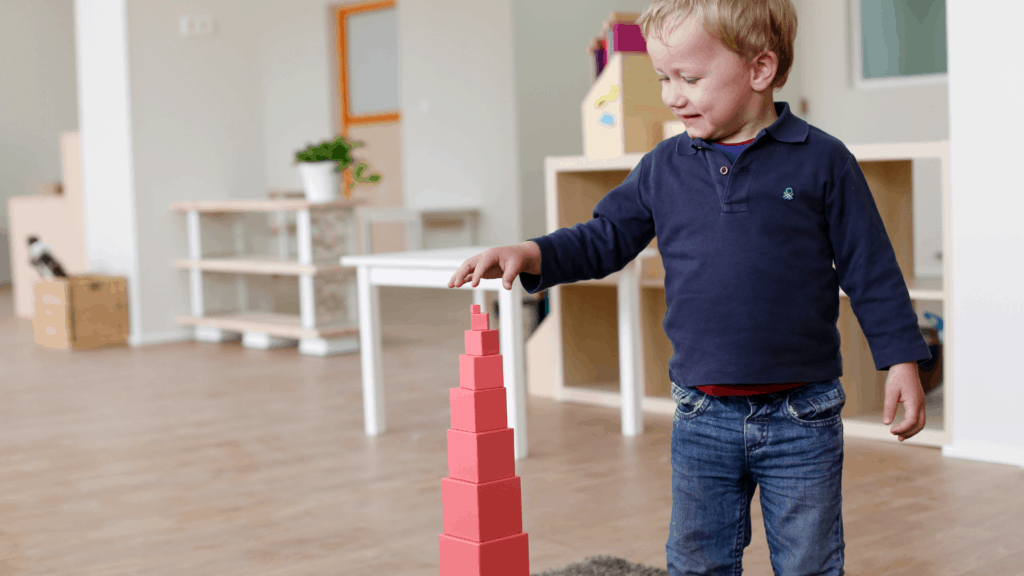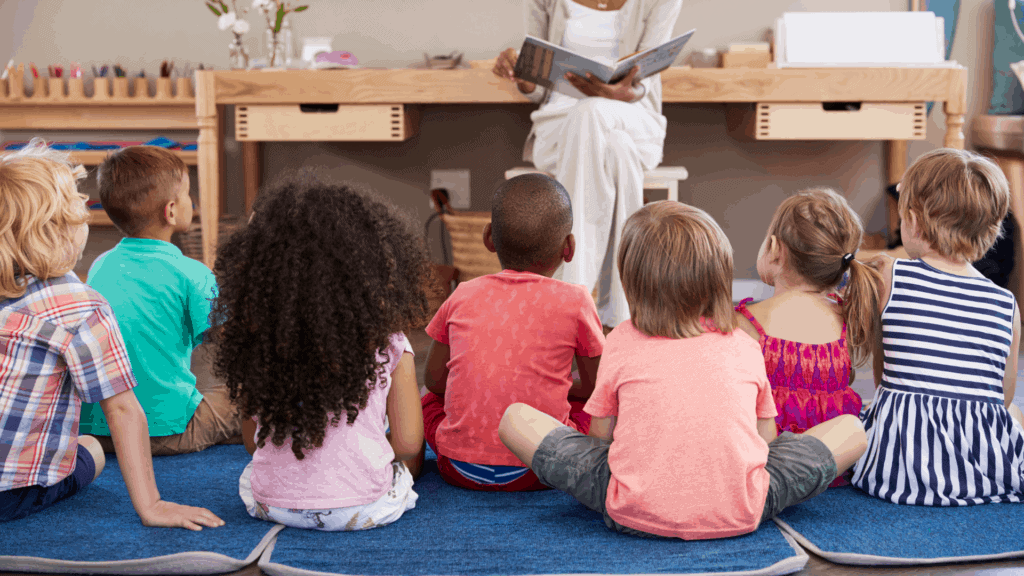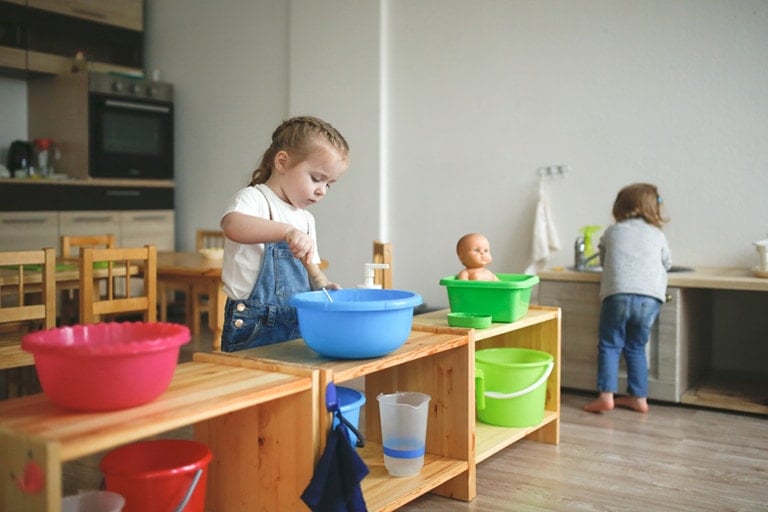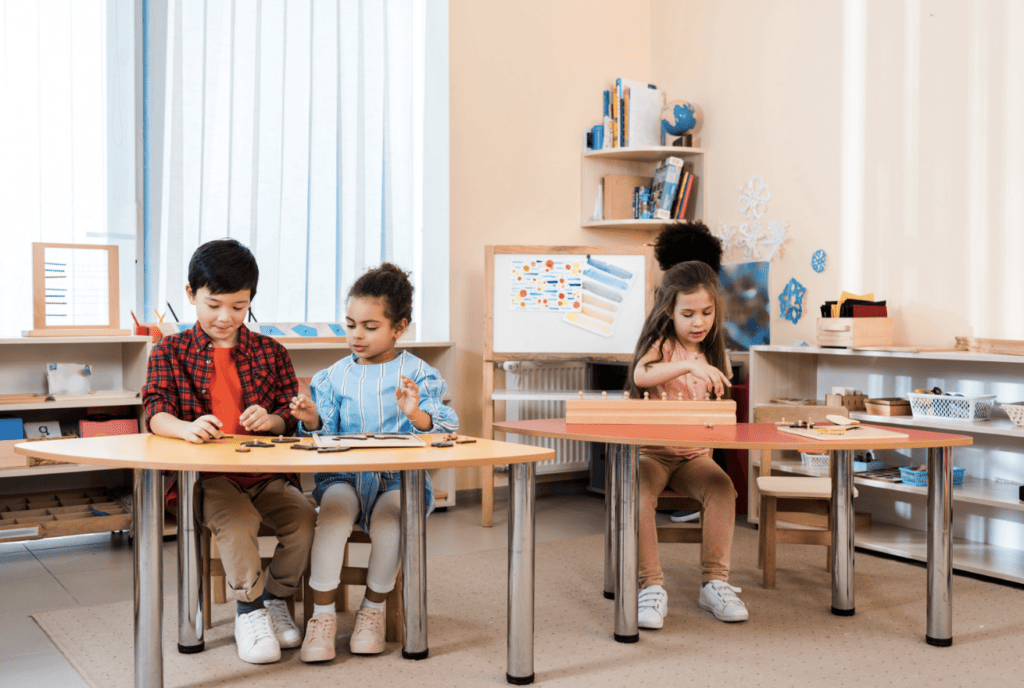In this article, we will look at the similarities and differences between the theories of Maria
Montessori and Piaget’s theories diverge on the specific stages of development and the importance of social and cultural aspects of learning, but they have much in common. Both share an emphasis on child-centered classrooms, repeating lessons as needed, and allowing children to learn at their own pace. More importantly, they share a belief in the importance of sequential, discreet stages of development.
We will also see that Vygotsky plays a vital role. His views of the structural, sequential aspects of development diverge greatly from

Piaget and Pyschological Constructivism
Jean Piaget was a Swiss psychologist who lived between 1896 and 1980. He conducted his early studies at the Las Maison de Petit school in Geneva. This was an experimental nursery school based on Maria Montessori’s ideas. He also served as the head of the Swiss
Piaget’s Four Stages of Cognitive Development
Piaget’s stages of development are called ‘discreet’ which means they adhere to a certain order that should not, and cannot be rearranged or reordered. These periods are flexible guidelines that may vary from child to child. Some periods may overlap, and some children may learn faster or slower. The stages, however, cannot be skipped. This is why they are more commonly referred to as ‘hierarchical’.
1. Sensor-motor Stage- This occurs during 0-2 years of age.At this stage, the child demonstrates and develops ‘Intelligence in action’.They do this by interacting with their environment through manipulating physical objects.At this point, children are using their senses to learn about the world.
2. Pre-operational Stage– This stage divides into two substages: the pre-conceptual stage (0-2 years) and the intuitive stage (4-7 years). At this point, children are still predominately self-centered. Although the child’s thinking is dominated by sensory perception, they become more and more capable of symbolic functioning; language development occurs.
During the intuitive stage, the child will begin to go beyond sensory perceptions, but they are still overtly influenced by their perception of the environment. Children only acquire the basic skills of symbolic functioning; they can’t quite understand abstract reasoning or logic.
3. Concrete Operational Stage
This stage occurs during age 7-11, sometimes age 12. Logical reasoning and critical thinking are developed at this time. Children can organize knowledge, classify objects and work on rudimentary thought problems, but logical reasoning can only be applied to objects that are “real” or can be seen (i.e physical objects, not metaphysical objects, such as “contradictions” or “justice”).
4. Formal Operational Stage
This occurs during ages 11-12 and up. Now the child can think realistically about their future. The individual can now think logically about things beyond physical or real objects. Thinking about potential events and abstract ideas begin. Here one gains the ability to solve abstract, complex problems.
These are the stages that all humans must pass through, according to Piaget, to achieve full intellectual and psychological maturity. Reaching the next stage and developing properly is not a given, however. For example, studies have shown that one-third of adults have not reached the Formal Operational Stage (Theories of Development– William Crane 2005).
When a child’s development is not addressed according to these stages, or they do not succeed in moving on to the next stage, this causes boredom in students. This, in turn, leads to teachers moving from topic to topic, subject to subject, and in a traditional classroom environment, some kids get left behind in the process.
One thing to note is that Piaget’s theory is generally devoid of any social or cultural context when he lays out these stages. It is a purely psychological theory. It takes place in a typical classroom setting; Lessons are structured and predetermined, and students do not choose their activities.
See Also: What are Play Schemas?
Vygostsky and Social Constructivism
Lev Vygotsky was a Russian psychologist from Belarus, in the former soviet union. He died, tragically, at the age of thirty-seven, in 1934. His theory is known as the sociocultural theory of development. Unfortunately, we have no idea what his theory might have been, had his life not been cut short by Tuberculosis.
The first, most important aspect to note about Vygotsky’s theory, for purposes of our comparison, is that community and language are essential aspects of learning. Also, he does NOT believe that children necessarily develop in stages. He believes that children develop independently, according to their own process, as the result of social interaction.
This development occurs via what he calls the Four Elementary Functions:
- Attention
- Sensation
- Perception
- Memory
These are the abilities that all humans have from birth. He begins with the earliest possible explanation because he is laying down not just an education or development theory, but a full epistemology that explains how learning and knowledge are possible (we will explain this further in a moment). By using these four abilities in society, we gain higher, more complicated mental abilities.
These are also abilities that we can use independently, without the aid of a parent, teacher, or mentor. These people are what Vygotsky would call “More Knowledgable Others”. He emphasizes the role of these others in development, over and above any hierarchical system. Instead of sequential models, his notion is based on modeling and guided practice.
He also notes that this ‘more knowledgable other’ could be a technological tool, such as a book or an electronic device, not necessarily a present human being. You might think of this as a “Knowledgable Other, by Proxy”.
This all occurs in what Vygotsky calls the zone of proximal development. This is the category of things that we can do with the help of a More Knowledgable Other. Beyond this zone are things that are beyond the scope of our current ability. For example, you can’t teach a baby to play the piano and you can’t teach a toddler to diagram a sentence. It is simply beyond their zone of proximal development, according to Vygotsky. This is why he might say it’s not a good idea to teach philosophy to children who are too young. The concepts may be beyond their reach.
Note, that while there is a clear path of progression here (left to right), making this a “constructivist” theory, this is different than passing through hierarchical stages, as we see with
An interesting result of this is that we might find situations where a child’s learning precedes their development. This explains how a child might develop a skill that goes beyond their natural maturity. For example, children who are prodigies at chess, mathematics, or music. This is not something to be ordinarily expected in the normal course of development, according to this theory, however.
Another important result of this theory regards the internalization of language. Children who have not completed this aspect of development are limited to “thinking out loud” when they use language. A child must develop in such a way that ‘internal language’ and spoken language are independent. This internalization of language is what produces higher thought.
Check out our full information for more information on Vygotsky vs Montessori.
Montessori Solutions: A Cognitive Approach
So, how does the
The
The
Montessori and Piaget both believe children develop in sequential order, which necessarily builds on the development that came before. As one acquires experience, this is processed by the rational mind, which leads to further experience, which leads to development and learning. This mirrors the
Despite these similarities,
Montessori Planes of Development
Birth-3 years: Focuses on the absorbency of the mind and learning from the senses.
18 months: 3years: Muscle development and physical coordination begin. Children focus on smaller objects.
2-4 years: Physical movement becomes more refined. Time and space perception develop; sequences in time and space are realized. The child becomes aware of notions of truth and reality.
2.5-6 years: The senses are developed. The processing of sensory information is refined.
3 -6 years: Children become susceptible to adult influence. Good and bad examples begin to set in.
3.5-4.5 years: The focus is on writing and written language skills.
4-4.4 years: The tactile senses begin to mature. Sense of taste and touch develop.
4.5-5.5 years: The focus is on reading. Acquiring information using the language skills that have been developed.
As you can see, these planes are quite different in focus and organization than Piaget’s stages. One result is that the Montesorri method does not get hung up on the concrete operation stage, or any particular stage. It acknowledges “sensitive periods” where it’s best for a certain kind of learning to occur but realizes that it’s never too early to begin developing the senses and laying foundations for higher learning.
Comparing Practical Methods: Montessori vs Vygotsky
In many ways, the
You might not teach a toddler to play piano, but you can let them get familiar with one. They’ll learn more just touching it than they would from a toy instrument! You can also begin playing music for them in the womb, to use a common example. This also means children are assumed to be capable of learning reading, writing, and arithmetic much earlier than under Piaget’s theory.
The Piaget and
Piaget focuses on the individual child, one child at a time. Conversely, Vygotsky focuses on groups of children and social learning. We learn social skills through language. This is the primary focus of learning and teaching. Using these skills, we develop the complete child as a total package. We go beyond academic learning and problem-solving.
In this way,
It is important to keep in mind that many of these differences become clear when we note that Piaget and Vygotsky are clearly constructivists, whereas there is some debate as to how
Montessori and Constructivism
Montessori initially focuses on the senses and sensory processing.
-Constructivists initially focus on meaning and organization.
The
-Constructivism relies on input from teachers for correction.
Montessori encourages “error-filled experimentation”. Self-correcting materials act as a control.
-Constructivism avoids discouraging wrong answers.
Montessori emphasizes individual works and the importance of personal choice.
-Constructivism emphasizes cooperative group projects and group discussions.
Montessori emphasizes proper social dynamics in the classroom. Courtesy, respect, and love are expected.
-Constructivists believe suppressing conflict can hinder a child’s development by causing them not to consider opposing points of view.
Montessori believes children’s proper behavior and discipline come from “joyful obedience”, based on a fundamental worldview, and that teachers are there to guide, not to discipline.
-Constructivists believe the teacher is a knowledgable companion who forms a personal, equal peer relationship with the children.
Some Basic Advantages
An important question to ask when comparing these theories is which comes first, social learning, or development? This was a point of contention between Piaget and Vygotsky. For Piaget, whose views were primarily psychological, a child must first develop to a certain intellectual degree, even if only a little, before they could acquire the ability to interact socially. But for Vygotsky, whose views were primarily social, the only way a child could develop any intellectual ideas was through socializing with others! So which comes first, the chicken or the egg?
The Montessori method provides a clear way out of this conundrum. Social learning and development are interrelated, symbiotic, and happen simultaneously. From the moment of birth, a newborn human is already socially interacting with the first person it sees, and in that very process, is already learning something. This relationship and how it works should be the focus, rather than neglecting one process for the other. Here we see a familiar pattern! One might think of a feedback loop. They are two things that are caused and created by each other.
While the
One of Maria
Unlike Piaget’s or Vygotsky’s method, the
The focus of the
The
Conclusions
So, now that we have a lot of complicated information, let’s wrap this all up in a nice, simple package!
Piaget and Vygotsky have fundamental disagreements. Some they have in common with
Traditional classrooms are not adequate for developing children to the formal reasoning of Piaget. Piaget’s method is inadequate for explaining the social and cultural aspects of learning or preparing children for it. Vygotsky’s method is inadequate in providing a structure that clearly explains how development happens, and thus, any guide for navigating through it. This is why the
“Children are better prepared to be independent and responsible individuals through cosmic education and
-MariaMontessori method.”Montessori







